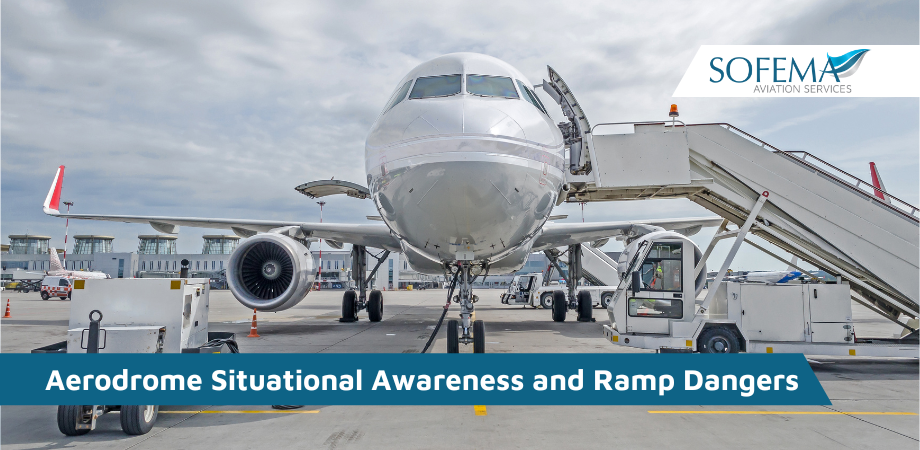Sofema Aviation Services (SAS) www.sassofia.com takes a look at a number of challenges within the Aerodrome Ramp Area.
Introduction
Situation Awareness is essentially an awareness of what is happening around you and how you connect with this understanding.
Situational awareness is the perception of environmental elements and events with respect to time or space, the comprehension of their meaning, and the projection of their future status.
The Ramp can be a very dangerous place to work with accidents potentially leading to human injury or even death as well as the possibility (very expensive) of damage to aircraft.
Targeted & Focused Training is important to raise the standard of safety on the ramp without overwhelming the workers. Safety-related communications can provide a positive result supported by a focus on all things related to safety and safe working practices.
Safety & Safety Management (SMS) theory is important to drive a safe system but to be effective the system requires to be implemented & visible.
Safety is a Top-Down Process but it requires Bottom-up Engagement with a Peer driven safety message have significant value. It is important for workers to “want” to do the task correctly the right way – all the time! (not just when being observed)
Focusing on Situational Awareness
Situation Awareness typically involves the following elements:
a) Extracting information from the Environment;
b) Integrating this information with relevant internal knowledge to create a mental picture of the current situation;
c) Using this picture to direct further perceptual exploration in a continual perceptual cycle; and
d) Anticipating future events.
Situation awareness has been found to be critical to performance and error prevention in many environments with the need to develop training to improve situation awareness during all ramp operations.
How to Communicate with Front Line Staff
- Short Videos – Max 10 Mins of Procedures.
- Understand the right way as well as the wrong way of doing tasks.
- Promote active safety mentoring to drive safety working behaviours.
Encourage Reporting
Measuring Safety Performance is a challenge to measure – for example how to measure the exposure related to an accident that never happened?
The willingness to report events, as well as near misses is an essential tool that management can use to prevent today’s incidents from escalating into more serious situations later.
- Employees are encouraged to report near-misses, without fear of being blamed.
The Challenge of Short Turnarounds
Aircraft on 35-40 minutes layovers can raise the exposure especially when hold-ups occur. For example, if a queue of vehicles builds up, perhaps because of a conflicting aircraft movement, the driver’s natural reaction is to recover lost time.
Situational Awareness Considerations
In examining human error that may occur within the maintenance arena, a number of issues can be identified:
a) The first involves shortcomings in the detection of critical cues regarding the state of the aircraft or sub-system.
b) Incidents exist of aircraft being returned to service with missing parts or incomplete repairs.
c) Frequent errors include loose objects left in aircraft, fuel and oil caps missing or loose, panels and other parts not secured, and pins not removed.
Final Comments
Often when important information is perceived, there may be difficulties in properly interpreting the meaning or the significance of that information.
While the symptoms may be observed correctly, a significant task remains in properly diagnosing the true cause of the failure.
There is a specific need for a clear understanding of responsibilities and good communication between individuals to support the performance of shared tasks.
In addition to ensure coordination of activities and provision of information across teams to those on different shifts or in different geographical locations.
Next Steps
Follow this link to our Library to find & Download related documents for Free.
Sofema Aviation Service (www.sassofia.com) provides Classroom & Webinar Training covering Ramp Safety & Ramp Human Factors Training – Please see the following course: Aircraft Ramp Safety and Ramp Human Factors Initial Training – 2 Days or email Team@sassofia.com if you have any questions or need additional details.
Tags:
Aerodrome, Aerodrome Ramp Area, Aerodrome Safety, Aerodrome Situational Awareness, Aircraft Ramp Safety, aviation, aviation safety, Measuring Safety Performance, Ramp Human Factors, Safety Management Systems (SMS), SAS blogs




